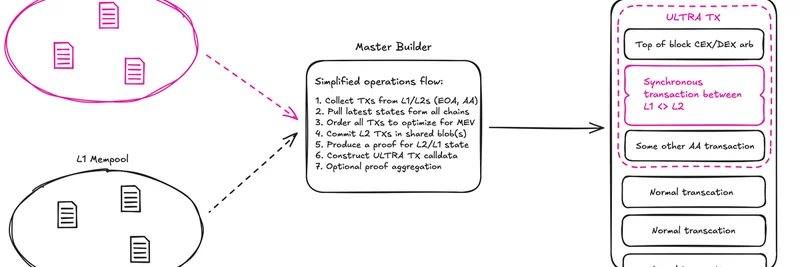Hey there, blockchain enthusiasts! If you've been keeping an eye on Ethereum's evolution, you know scalability and composability are hot topics. Today, we're diving into an exciting thread from Taiko's Gwyneth that unveils ULTRA TX—a clever way to make Ethereum blocks more programmable and achieve synchronous composability without needing a hard fork. Let's break it down step by step, keeping things simple and straightforward.
Why Do We Need ULTRA TX?
First off, let's talk about the problem. In the current setup, cross-chain interactions often feel clunky. You're dealing with asynchronous messages, relays, and a whole lot of "fingers crossed" moments. Without a shared standard for chains to interact with each other's state, user experience (UX) suffers. ULTRA TX steps in as a common, programmable layer that coordinates everything right inside the Ethereum block itself. Think of it as giving chains a way to "high-five" in real-time.
The Core Idea: A Fat Transaction at the Top
At its heart, ULTRA TX is like one massive transaction sitting at the very top of the Layer 1 (L1) block. Inside this "fat" tx, you can bundle account-abstracted (AA) meta transactions, compose actions across Layer 2s (L2s), share blob space for efficiency, and even aggregate proofs—all atomically, meaning it either all succeeds or nothing does.
Why the top of the block? It ensures immediate access to the latest L1 state, like the header from the previous block. This avoids complicated workarounds for reasoning across transaction boundaries. The best part? No L1 hard fork required—just some cooperation in the Proposer-Builder Separation (PBS) ecosystem.
Addressing the "Top-of-Block is Precious" Concern
You might wonder, isn't that prime real estate in the block? Absolutely, but ULTRA TX can include high-value L1 order flow, like centralized exchange (CEX) to decentralized exchange (DEX) arbitrages, while still handling cross-chain logic. The rest of the block builds normally afterward—no subsidies needed.
What Changes for Users?
Over time, L1 transactions shift toward account abstraction meta txs, moving away from Externally Owned Account (EOA) limitations. This simplifies cross-chain UX and makes synchronous L1 to L2 workflows feasible. With EIP-7702, users can opt-in easily with just a signature, making the whole process smoother.
Who Builds This Super Transaction?
Enter the "Master Builder"—a combo of L1 AA bundlers and based rollup block builders. This entity assembles the ULTRA TX, spanning L1 and L2 work, and proposes it on L1. It's like having a conductor for a multi-chain orchestra.
The Big Wins
So, what do we get out of this?
- Atomicity Across Transactions and Chains: Everything happens together or not at all.
- Shared Blob Packing and Compression: L2s save on data costs.
- Amortized Proving: One proof for multiple actions, reducing overhead.
- Unified Mempool Semantics: Consistent rules across L1 and L2.
- A simpler developer experience overall.
Atomicity is the real unlock here. Today, enforcing constraints across txs is nearly impossible. With ULTRA TX, the entire program can check proofs and revert if anything's off—just like on a single chain.
Extending L1 Without Hard Forks
How do we add features without changing Ethereum's core? Use an "ExtensionOracle" pattern: When L1 needs something extra, like a cross-chain call, the builder proves the output and feeds it back via transient storage. Contracts treat it as native.
On L2s, a small precompile (like XCALLOPTIONS) handles chain switching for external calls. Builders simulate L1 and L2 together, record outputs, and apply them in order when proposing the ULTRA TX.
This setup powers synchronous composability: An L1 swap can call an L2 lending market, which calls another L2 DEX, and return to L1—all in one tx, with a single proof and predictable ordering.
Rollout: Gradual and Flexible
Implementation will be phased in. Not every block needs an ULTRA TX at first—it can start small, with limited scope and proofs, growing as provers improve. Non-ULTRA txs still fit in after it, ensuring backward compatibility.
Wrapping It Up
In summary, ULTRA TX places a programmable "super-tx" at the top of L1 blocks, letting L1 and L2 compose synchronously, pack data efficiently, and amortize proofs. Normal txs follow, and UX migrates to account abstraction. Ethereum starts feeling like a unified chain again—exciting times ahead!
If you're into rollups like Taiko or exploring how this could boost meme token ecosystems on Ethereum, keep an eye on developments. For more insights, check out Taiko's Discord. What do you think—could this be the key to seamless multi-chain experiences?



